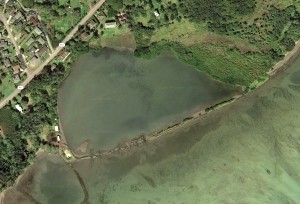Hokukano-Ualapue Complex
Introduction
Text-to-speech Audio
This site, which covers a large area not far north of Hwy 450, is one of the most important pre-contact archaeological sites in Hawaii and remains of great significance to native Hawaiians today. It consists of two fishponds and seven temples (heiaus). One of the temples is the second largest in Hawaii, whose top platform, out of four, is 287 feet long by 87 feet wide. The site was in use from 1500 A.D. until 1778, when Europeans finally arrived in Hawaii.
Images
Aerial photo of one of the fishponds.

Backstory and Context
Text-to-speech Audio
The site represents highly sophisticated engineering and a highly stratified society. It indicates that the chief at the very top of society held significant religious, political and economic power. Hawaiians today associate many of the structures at the site with Hawaiian legends, rulers and events. Portions of the site are located on private land so permission is needed to visit those areas.
Sources
Dunbar, Helene. "Hokukano-Ualapue Complex." National Park Service, National Register of HIstoric Places. October 15, 1966. http://focus.nps.gov/pdfhost/docs/NHLS/Text/66000304.pdf.
"Hokukano-Ualapue Complex: Island of Molokai, Hawaii." National Park Service. Accessed September 3, 2016. https://www.nps.gov/nr/travel/asian_american_and_pacific_islander_heritage/Hokukano-Ualapue-Complex.htm.
